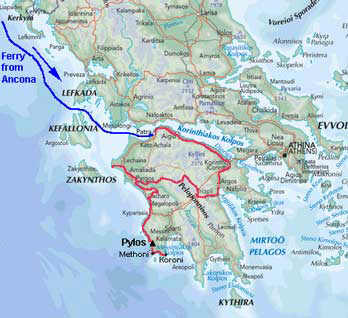 OUR GREEK ODYSSEY - Week 4
OUR GREEK ODYSSEY - Week 4
Week 4 Photos Bottom of page
Return to Index-page
|
This week we have explored southern Messinia, the SW corner of the Peloponnese, an area steeped in history going back 3,500 years to the Mycenaean Bronze Age. 'Sandy Pylos' as Homer called it was the site of the huge Mycenaean palace, ruled over by Nestor, the tediously garrulous old Chieftain who brought his 90 ships to the Greek expedition against Troy, and bored everyone with his home-spun wisdom. He returned from Troy to rule over his sandy kingdom for many years until invaders destroyed his palace by fire around 1200 BC. Sphacteria, the long island which encloses the bay, was the scene of a famous debacle during the Peloponnesian War in 425 BC, when a small force of Spartans fortifying the island were compelled to surrender by an Athenian fleet (Dave, Andrew and Colin: the view is as vivid as Thucydides portrays it). Pylos Bay is the only safe anchorage along the whole western seaboard of the Peloponnese, and the Turks during their 400 years occupation of Greece fortified Pylos to protect the port. But they got their come-uppance at Navarino Bay in 1827 when a small squadron of British, French and Russian warships annihilated a massive Turkish fleet within the confines of the bay. This 'untoward incident', as Wellington described it, ensured the successful outcome to the Greek War of Independence. Our campsite on the shore of the bay would have given us a grandstand view of the battle. After our journey down the west coast, we reached Navarino on Friday evening and camped at the water's edge looking out across the bay to Sphacteria Island. This beautiful unspoilt coastline needs however to be enjoyed while it lasts: the developers are moving in rapidly and soon it will be a succession of concrete boxes on stilts, discos and all. We hoped for the perfect sunset photo, but gloomy weather set in and we had to wait for several days to get photo 1 looking out westwards across the bay. The modern town of Pylos nestles at the foot of steep hills around its small harbour, where we treated ourselves to lunch: grilled octopus, merides (whitebait) and a dish of spinach-like vegetable called chorta (actually dandelion leaves) - Greek cuisine is, shall we say, distinctive. A breezy walk around the restored ramparts of the Turkish fortifications overlooking Pylos was the perfect antidote to such a lunch. On Sunday, the overcast weather turned to drizzly rain. This was the day to visit the impressive Archaeological Museum at Chora, 10 kms north, where most of the magnificent finds from Nestor's Palace and the associated royal tombs are displayed. What finer way to spend a wet Sunday afternoon than admiring this wonderful pottery, weapons, jewellery and household wares, over 3,000 years old from the late Bronze Age. Most impressive were the preserved fragments of frescoes which had decorated the walls of Nestor's Palace. Monday was again overcast, so we decided to investigate Methoni on the SW tip of Messinia, which we imagined would be a bustling little harbour full of interest with its imposing Venetian fortress. In fact, even on a weekday lunchtime, the town was utterly deserted - nothing or no-one stirred. But the fortress was another fascinating piece of the history of this corner of Greece. Built by the Venetians in the 13th century to protect their trading routes to the middle east, it changed hands several times in typically bloody fashion over the next 400 years, until the Turks finally gained mastery by butchering everyone else. They were finally booted out in 1828 when Greece gained her independence .... and nothing seems to have happened in Methoni since. The castle is built on a rocky promontory, surrounded by sea on 3 sides (see photo 2) - mighty impressive military architecture. Methoni's twin Venetian staging-port, Koroni, on the SE tip of the peninsula and also overlooked by a fortress, proved to be all that Methoni wasn't - a delightful Mediaeval town of white houses spilling down narrow cobbled lanes to the harbour where we lunched at a fish-taverna later in the week. Sunny weather finally returned on Tuesday, making it the perfect day for visiting the excavated remains of Nestor's Palace, built in 1,300 BC. This large complex of royal appartments, staterooms, and magazines for olive-oil, wine and pottery, was the centre of a powerful kingdom. The scientifically conducted excavations of the 1950/60s not only produced the wonderful finds and frescoes displayed in Chora Museum, but also revealed so much of the palace's layout. The centrepiece is the King's throne room, with its huge central circular hearth (see photo 3), and the stone/stucco bases of the columns which supported a gallery around the upper storey. On a more human scale, the excavations brought to light the royal bathroom, complete with its inscribed bathtub. There before our eyes was the scene from Homer's Odyssey where Nestor's daughter prepares the bath for their guest Telemachos, Odysseus' son come to seek news of his father's whereabouts since leaving Troy. And the store rooms still had the remains of huge jars which contained olive oil, paid in taxes by Messinian subjects, and documented by palace bureaucrats in archival records inscribed on clay tablets in Linear B script, a primitive dialect of Greek. The visit to Nestor's Palace really was a remarkable experience. After such a feast of history, Wednesday was a wild-life day. At the north end of Navarino Bay, a lagoon, separated from the sea by elongated hills, is home to a rich variety of fauna and flora: we hoped to see such birds as egrets, cormorants, herons, and higher up buzzards and peregrine falcons, and even turtles and chameleons along the shore line. From the narrow straits separating Sphacteria Island, we climbed up the southernmost 400 foot limestone hill, which is topped by the remains of another Frankish castle; this is the hill over which the sun set, viewed from our camp (photo 1). The descent down the craggy northern side was somewhat more hairy, but brought us down to a huge cave, said by legend to be where Nestor kept his cattle (though how he got them 300 feet up a narrow, craggy path winding through juniper trees, is not explained!). But the panoramic views down across the dunes to Voidokilia Bay were simply breathtaking. This was the perfect cove, an almost 300° circular sweep of silver sand, with just a small opening of the shallow, blue water to the sea (see photo 4). 1st May is a public holiday in Greece. We asked the campsite boss how it is traditionally celebrated. "It is a good day" he explained - "no work", which seemed reasonable. Another eventful week, and 1 month into the trip. Next week we shall move round to the Mani, the wild and barren mountainous southernmost peninsula of the Peloponnese, and before that, make a 2 day foray into the Messinian mountains to explore ancient Messene. More next week. Sheila and Paul Published: Saturday 1st May
|
 Week
4 news: South Messinia and Pylos
Week
4 news: South Messinia and Pylos